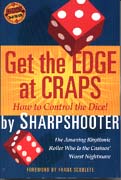
Get the Edge at Craps
How to Grip the Dice For Maximum Control
 Chris Pawlicki (AKA Sharpshooter) has an engineering background which he has put to good use in his dice control research. He and Jerry Patterson created the "dice control revolution" with the development of the first dice control course in 1996. He published his own book, How to Control the Dice in 2002, and launched Sharpshootercraps.com in 2003. Chris's website is www.sharpshootercraps.com ReadyBetGo has been selected as the initial site for the publication of previews and excerpts from this book. Please be sure to visit our site for the latest from SharpShooter and Jerry Patterson.
Chris Pawlicki (AKA Sharpshooter) has an engineering background which he has put to good use in his dice control research. He and Jerry Patterson created the "dice control revolution" with the development of the first dice control course in 1996. He published his own book, How to Control the Dice in 2002, and launched Sharpshootercraps.com in 2003. Chris's website is www.sharpshootercraps.com ReadyBetGo has been selected as the initial site for the publication of previews and excerpts from this book. Please be sure to visit our site for the latest from SharpShooter and Jerry Patterson.This serves several purposes:
1) Minimal contact area making it easier to release;
2) Ability to "pinpoint" my fulcrum line, about which the dice will rotate off when they do release.
3) I can create that very "Sharpshooter tight" formation that you see when the dice are airborne and in slow-mo on the videos;
4) I can also more finely tune my revolutions for any throw;
5) I can more keenly "feel" the dice coming off my hand and any slight variation in release is amplified.
So you can see there are multiple benefits to gripping this way - if you are able to effectively do so. The Three-Fingered Front can be tough to learn and this is a further extension from that.
There are three things to check for when you initially grip the dice:
1. Dice do not splay apart (opening up in front by yawing away from each other and rotating about the thumb).
2. Your three fingers are properly centered laterally, or side-to-side. If they are centered, then you will not be favoring one die over the other. The more contact area on one die, the more clamping pressure and frictional forces to overcome. This causes that die to lag or come out in a lower trajectory, or a combination of both.
3. Your three fingertips, or contact pads (depending on whether you are a "tip gripper" like I am, or a "pad gripper" like mostly everyone else) should be parallel with the dice bottoms and table bed. Your fingertips act like a fulcrum as the dice pivot about them upon release. Everything is setup in a side-by-side relationship, so it is important that your fingertips are gripping in the upper half dice faces and are equidistant from the top edge.
Some additional points I would like you to consider in general are:
4. You should be minimizing contact area and pressure when gripping such that the dice just "float" right out of your hand as you release them. This should occur without any additional arm acceleration or wrist snap; just a nice, constant fluid swing.
5. Also, you must have just enough gripping contact so that the dice do not slide or shift in your hand before you intend to release them. They must remain flush across their faces and maintain their alignments.
Points 4 and 5 above seem to be conflicting, however you must balance them as delicately as possible to optimize dice-to-hand equilibrium and minimize drag release at the same time.
Follow the above suggestions and your control of the dice should improve as should the number of times you roll during the point cycle.
For more information, contact Sharpshooter at: Sharpshooter@Sharpshootercraps.com.

